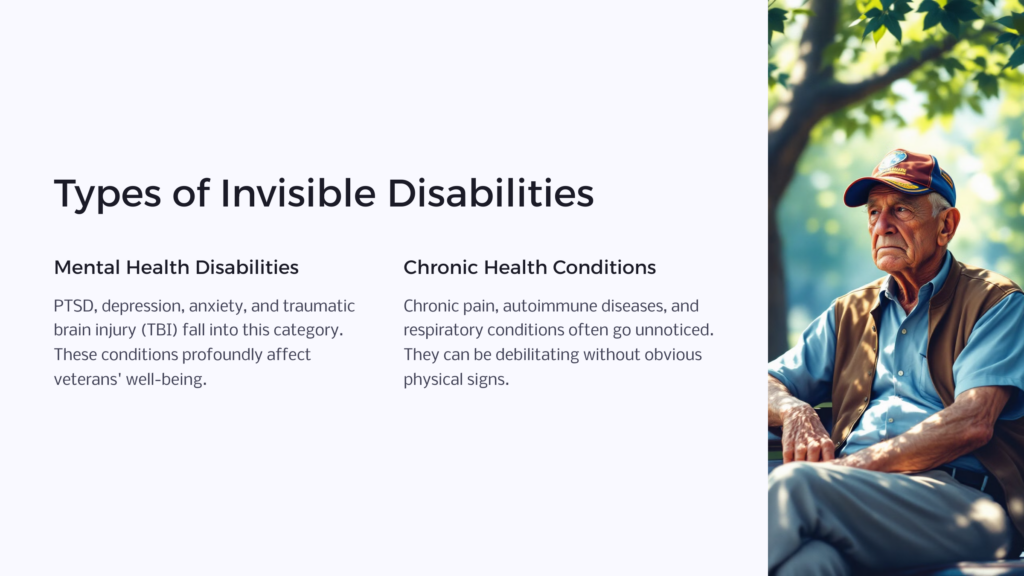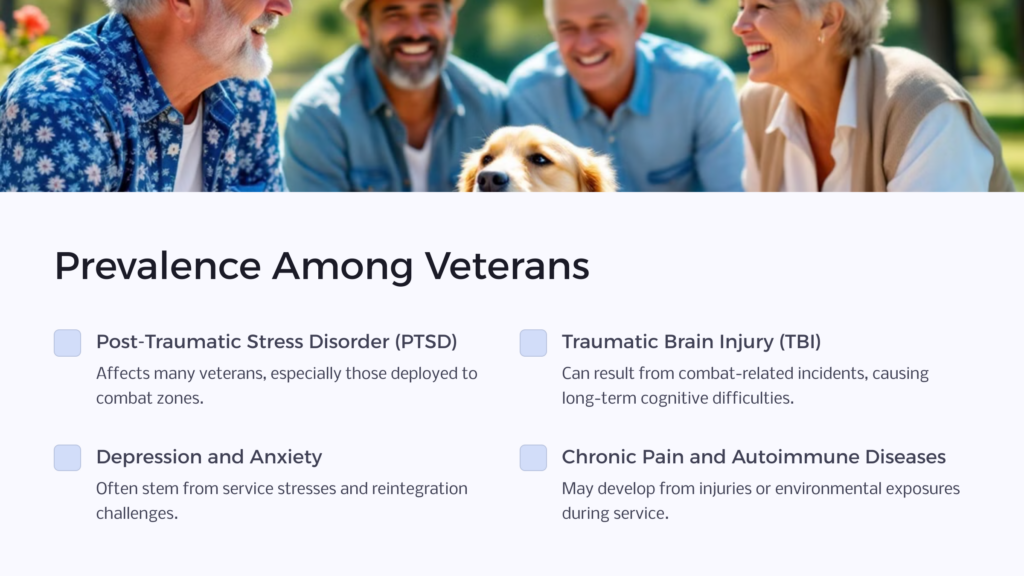No two stories are the same in life, and our challenges are as diverse as the paths we walk. For veterans and their families, the journey after service often unveils new challenges, some of which remain hidden. These challenges are known as “invisible disabilities.”

Invisible disabilities encompass many conditions that may not be immediately evident to others but can significantly impact an individual’s life.
These conditions range from mental health disorders like post-traumatic stress disorder (PTSD), anxiety, and depression to chronic illnesses such as traumatic brain injury (TBI), chronic pain, chronic fatigue syndrome, and autoimmune diseases.
An invisible illness is so named not because it is unreal or less severe, but because its symptoms and effects are not always visible to the naked eye.
Understanding Invisible Disabilities in Veterans

Regarding veterans’ health and well-being, “invisible disabilities” have gained massive traction as an umbrella concept encompassing many conditions that significantly impact individuals but may not be apparent to others.
Such a condition could be a physical disability, an intellectual disability, or a mental illness. These become particularly challenging to diagnose, manage, and address.
Invisible disabilities constitute a diverse spectrum of conditions, making it challenging to provide a one-size-fits-all definition. These disabilities can be broadly categorized into two main groups:
Mental Health Disabilities
Conditions such as post-traumatic stress disorder (PTSD), depression, anxiety, and traumatic brain injury (TBI) fall into this category.
While their symptoms may not be immediately visible, mental disorders can have profound and lasting effects on veterans’ overall well-being.
Chronic Health Conditions
Chronic illness is very often a hidden disability. Think about chronic pain, autoimmune diseases, respiratory conditions, and any other medical condition that can be debilitating yet may not manifest in obvious physical impairment.
Prevalence Among Veterans
The prevalence of invisible disabilities among veterans is a growing concern driven by several factors.
The nature of military service often exposes individuals to traumatic events, prolonged periods of stress, and environmental hazards, all of which can contribute to the development of invisible disabilities.
According to the U.S. Department of Veterans Affairs (VA), the most commonly diagnosed invisible disabilities among veterans include:
Post-Traumatic Stress Disorder (PTSD)
PTSD is a mental health condition that can develop after experiencing or witnessing a traumatic event.
It affects a significant number of veterans, particularly those who have been deployed to combat zones.
Traumatic Brain Injury (TBI)
TBIs can result from head injuries caused by explosions or other combat-related incidents. The long-term effects of TBI can range from cognitive difficulties to mood disorders.
Depression and Anxiety
The stresses of military service, including deployments and the challenges of reintegration into civilian life, can contribute to developing depression and anxiety disorders.
Chronic Pain
Veterans may experience chronic pain from injuries sustained during service, leading to musculoskeletal disorders or nerve damage.
Autoimmune Diseases
Exposure to environmental toxins during deployment has been linked to the development of autoimmune diseases, which can profoundly impact a veteran’s quality of life.
VA Benefits for Veterans with Invisible Disabilities

Financial compensation
Veterans with service-connected invisible disabilities, including mental health conditions like PTSD and physical conditions like traumatic brain injury (TBI), may be eligible for VA Benefits.
Like unemployment insurance, this financial support is designed to provide veterans with a monthly payment based on the severity of their disability.
Healthcare Services
The VA offers comprehensive healthcare services to eligible veterans with the required VA disability rating, including those with invisible disabilities.
This includes access to mental health care, specialized treatment programs for conditions like PTSD, and medical services to manage chronic health issues.
The VA has specialized centers and clinics that provide care for veterans with conditions like TBI, offering comprehensive assessment, treatment, and rehabilitation services.
Vocational Rehabilitation and Employment (VR&E)
VR&E services assist veterans with service-connected disabilities, including invisible disabilities, in achieving meaningful employment.
These services may include career counseling, vocational training, educational assistance, and job placement support.
Veterans with invisible disabilities may receive accommodations to help them succeed in the workplace, such as assistive technology, modified work schedules, or workplace modifications.
Mental Health Services
The VA strongly emphasizes mental health services for veterans, recognizing the prevalence of conditions like PTSD and depression.
Veterans with invisible disabilities can access individual and group therapy, medication management, and crisis intervention services.
Navigating the VA Claims Process

Filing a disability claim with the Department of Veterans Affairs (VA) can be complex and sometimes challenging, especially for veterans with invisible disabilities.
Understanding and navigating the claims process effectively is crucial to ensure that veterans receive the benefits they deserve.
Gather key Documentation
Collect all relevant Documentation related to your invisible disability.
This may include medical records, doctor’s notes, statements from fellow service members, and any supporting evidence that demonstrates a clear connection between your disability and your military service.
Determine Eligibility
Verify your eligibility for VA benefits. Eligibility often depends on your military service history, the nature of your disability, and the degree of disability.
The VA provides specific guidelines to determine eligibility for compensation.
Complete the Claim Application
To initiate the claims process, complete VA Form 21-526EZ, Application for Disability Compensation and Related Compensation Benefits.
You can fill out this form online through the VA’s website or seek assistance from a Veterans Service Officer (VSO) or veterans service organization (VSO) like the Disabled American Veterans (DAV) or Veterans of Foreign Wars (VFW).
Submit Supporting Evidence
Include all relevant medical and military records with your application.
This evidence is critical in establishing the service connection and severity of your invisible disability.
Be as thorough as possible, and ensure your Documentation links your disability to your military service.
Attend Compensation and Pension (C&P) Examinations
The VA may request that you attend a Compensation and Pension (C&P) examination with a VA healthcare provider.
This examination helps assess the severity and impact of your disability. Attend these appointments, and be honest and detailed about your symptoms.
Keep Track of Your Claim Status
Use the VA’s online portal (eBenefits) or call the VA’s toll-free number to check the status of your claim regularly. This will help you stay informed about the progress of your application.
Tips for Success
- Seek Assistance. Consider enlisting the help of Benefit.com or an attorney experienced in VA claims. We can provide valuable guidance, ensure your application is complete, and represent your interests in the appeals process.
- Be Persistent. The claims process can be time-consuming, and decisions may take several months or longer. Be patient and persistent in pursuing your benefits.
- Keep Copies. Make copies of all documents related to your claim, including your application, medical records, and correspondence with the VA. This will help you keep track of your application and provide proof of your efforts.
The Importance of Mental Health Support
Enhancing Quality of Life
Mental health support can significantly improve the overall quality of life of a veteran with an invisible disability.
Addressing mental health concerns can reduce symptoms, improve emotional well-being, and enhance daily functioning.
Suicide Prevention
Mental health issues are a significant risk factor for suicide among veterans.
A proactive approach to mental health support is crucial for identifying and intervening in suicidal thoughts and behaviors.
Improving Physical Health
Mental health is closely intertwined with physical health.
Untreated mental health conditions can exacerbate physical symptoms, complicate recovery, and lead to a cycle of declining health.
Strengthening Relationships
Mental health support can improve veterans’ relationships with family members, friends, and peers by helping them manage symptoms and communicate more effectively.
Tips for Veterans Seeking Mental Health Support
- Reach Out. Don’t hesitate to seek help. It’s a sign of strength to acknowledge and address mental health concerns.
- Talk to Your VA Healthcare Provider. Discuss your mental health concerns with your VA healthcare provider, who can help determine the most appropriate treatment plan.
- Engage in Treatment. Consistency in attending therapy sessions and actively engaging in treatment is critical to progress.
- Lean on Support Networks. Utilize the support of family, friends, and fellow veterans. You are not alone in your journey.
Employment Opportunities and Accommodations
Transitioning to civilian employment after military service can be a significant milestone for veterans with invisible disabilities.
Securing meaningful job opportunities and accommodation is essential for their successful workforce integration.
Leverage Veterans’ Employment
Services Federal and state workforce agencies often have specialized veterans’ employment services to assist in job placement. They understand veterans’ unique workplace skills and experiences and can help match them with suitable job opportunities.
Use Veterans’ Preference
Veterans may be eligible for preference in federal government hiring processes, giving them an advantage in securing federal employment. This preference is beneficial for veterans with service-connected disabilities.
Explore Veteran-Friendly Employers
Many private companies actively seek to hire veterans.
Research and target employers are known for their veteran-friendly hiring practices and support programs.
Networking
Connect with other veterans, attend job fairs, and join veterans’ organizations and online communities to network and gain insights into job opportunities.
Educational Assistance for Veterans
For veterans with invisible disabilities, pursuing higher education can be a transformative path toward career advancement and personal growth.
Post-9/11 GI Bill
The Post-9/11 GI Bill is one of the most comprehensive educational benefits available to veterans.
It provides financial assistance for tuition and fees, a monthly housing allowance, and a stipend for books and supplies.
Veterans with a service-connected disability rating may also qualify for additional benefits, such as the Yellow Ribbon Program.
Vocational Rehabilitation and Employment (VR&E)
The VR&E program, also known as Chapter 31, offers educational and vocational counseling, financial assistance for tuition and fees, and support for job placement.
Montgomery GI Bill
The Montgomery GI Bill (MGIB) provides financial assistance for education and training programs, including degree programs, apprenticeships, and on-the-job training.
The MGIB-Selected Reserve (MGIB-SR) is available for members of the Selected Reserve.
State Veterans Education Benefits
Many states offer veterans additional educational benefits and tuition assistance programs.
These benefits can vary widely, so it’s essential to research the options available in your state of residence.
Stay informed about changes in educational benefits and policies that may affect your eligibility or benefits. The VA and veterans organizations can help you stay up-to-date.
Community and Peer Support
Community and peer support networks are crucial in the well-being and successful reintegration of veterans with invisible disabilities.
These networks provide a sense of belonging, understanding, and shared experiences that can be immensely beneficial.
The Significance of Peer Support
Shared Understanding
Peer support networks consist of individuals who have experienced similar challenges, including the invisible disabilities often faced by veterans.
These shared experiences create a strong foundation for empathy and understanding.
Reducing Isolation
Veterans with invisible disabilities may feel isolated due to the stigma associated with their conditions.
Peer support groups offer a safe and non-judgmental space where veterans can connect with others who have walked similar paths.
Validation
Discussing challenges and experiences with peers can help veterans validate their feelings and experiences.
This validation can be empowering and reassuring, reducing self-doubt or shame.
Practical Guidance
Peer support groups often provide practical advice and tips for managing the daily challenges of invisible disabilities, whether they relate to mental health, chronic pain, or other conditions.
Building Resilience
Peer support can foster resilience by helping veterans develop coping strategies and providing emotional reinforcement during difficult times.
Connecting with Supportive Communities
Veterans Service Organizations (VSOs) Many VSOs, such as the Disabled American Veterans (DAV), Veterans of Foreign Wars (VFW), and the American Legion, offer support groups and community programs for veterans with invisible disabilities.
Contact your local VSO chapter to inquire about available resources.
VA Support Groups
The Department of Veterans Affairs (VA) often hosts support groups and therapy sessions for veterans with invisible disabilities. This includes those with PTSD, depression, and any other mental health condition.
Check with your local VA medical center for information on these programs.
Online Communities
Several online platforms and social media groups cater to veterans with invisible disabilities.
These virtual communities offer a platform for sharing experiences, seeking advice, and connecting with like-minded individuals. Websites like MakeTheConnection.net and various Facebook groups can be valuable resources.
Military Transition Programs
Some military transition programs guide connecting with peer support networks.
These programs are designed to help veterans navigate the challenges of transitioning to civilian life, including addressing invisible disabilities.
Peer Support Training Programs
Consider participating in peer support training programs that effectively teach individuals how to support others facing similar challenges.
Many organizations offer training to empower veterans to become peer mentors.
How Can Benefits.com Help Me?
For veterans with invisible disabilities, the path to a fulfilling post-service life can be challenging but not impossible.
Numerous benefits, services, and support networks are available to help veterans overcome these challenges and thrive in civilian society.
To learn more about these resources and to access additional information on veterans’ benefits, please visit us at Benefits.com.
We are committed to providing veterans and their families with valuable resources and guidance to navigate the complexities of invisible disabilities, and we invite you to explore our website for a wealth of information to support your journey.
 Benefits.com Advisors
Benefits.com Advisors
With expertise spanning local, state, and federal benefit programs, our team is dedicated to guiding individuals towards the perfect program tailored to their unique circumstances.
Rise to the top with Peak Benefits!
Join our Peak Benefits Newsletter for the latest news, resources, and offers on all things government benefits.




















